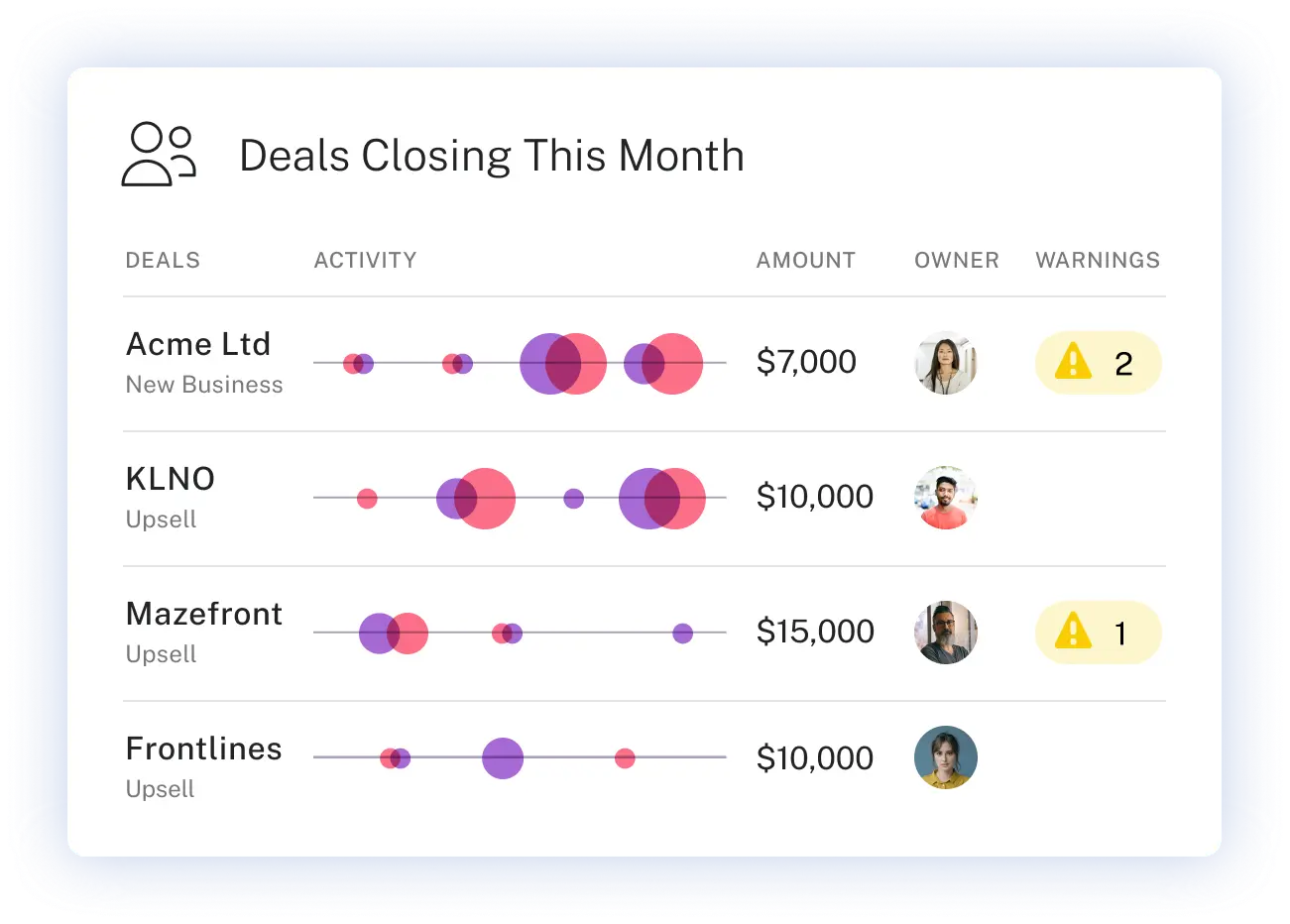5 revenue dashboards sales leaders can use to win
Right now, thousands of RevOps leaders are struggling to cobble together siloed data from spreadsheets, CRMs, and other tools. This approach significantly weakens their ability to manage pipelines and forecast revenue.
What RevOps leaders actually need is a solution that centralizes key financial metrics and revenue trends, automates the data collection process, and displays key insights in a way that’s easy to share with team members.
Revenue dashboards are that solution.
In this article, you’ll learn what revenue dashboards are, why you need them, useful variations you can build, and how a revenue AI platform can help.
What is a revenue dashboard?
A revenue dashboard is an interactive tool that presents sales trends and performance metrics in a visual format. It’s a core part of a revenue intelligence process that improves the way teams analyze and act on sales data.
Rather than trying to piece together data from dozens of sources, revenue dashboards provide a unified view of revenue.
Charts, graphs, and tables transform otherwise complex revenue data into clear, straightforward visuals. Then, you can leverage these insights to analyze current performance and inform future decisions.
Revenue dashboards allow you to take immediate action because they track sales performances as they happen and use that data to create relevant insights. You can monitor your team’s progress in real time, reassess your sales strategies, and optimize accordingly.
What data should you include in a revenue dashboard?
A revenue dashboard should include your company’s most important financial metrics. These are the key performance indicators most closely tied to sales.
Every RevOps leader will already track topline metrics like total revenue and customer lifetime value. But make sure to monitor these revenue-related metrics, too:
- Win rate: The percentage of deals reps close over a given period.
- Booking attainment: The percentage of a sales rep’s quota achieved through booked deals.
- Average deal size: The average value of deals over a given period.
- Average sales cycle: The average length of time it takes for deals to close.
While your CRM may track some of these metrics by default, you can automate AI-driven sales tools to track a much wider — and deeper — range of metrics.
5 types of revenue dashboards
Here are five common revenue dashboard examples along with the specific metrics they track and the insights they uncover.
1. Overall revenue
An overall revenue dashboard tracks key revenue KPIs and limits the noise of additional deep dive metrics. It includes the metrics listed above as well as several others:
- Monthly recurring revenue (MRR)
- Annual contract value (ACV)
- Year-over-year growth
It gives you a clear, uncomplicated view of your most important revenue figures. These big-picture sales trends give RevOps leaders a quick, yet comprehensive view of their company’s financial health. They also allow sales leaders to take immediate action when challenges arise in their pipeline.
2. Sales pipeline
A sales pipeline dashboard measures the health of your pipeline.
Since prospective deals are an indicator of future revenue, it’s important to know how many deals you have in your pipeline, what they’re worth, and their likelihood to convert.
Key pipeline KPIs include:
- Open deals
- Total pipeline
- Average deal value
- Opportunities by stage
Sales pipeline dashboards give sales managers and RevOps leaders a top-level pipeline view so they can spot issues or bottlenecks that may impact future revenue.
3. Sales activity
A sales activity dashboard measures sales reps’ day-to-day activities.
Its key KPIs include:
- Calls made
- Emails sent
- Meetings booked
- Closed deals
This dashboard offers real-time insights into individual and team sales activities. Sales managers can see whether teams are on track to hit their revenue goals and how individual reps are performing against targets.
Sales activity dashboards measure leading indicators that help forecast future revenue and identify coaching opportunities.
4. Customer success
A customer success dashboard measures how well you’re serving your current customers.
Its key KPIs include:
- Customer satisfaction (CSAT)
- Net promoter score (NPS)
- Onboarding completion rate
- Customer health score
Tracking customer success metrics improves the productivity of your CS teams, and helps them identify issues early so they can reduce customer churn.
5. Revenue forecast
A revenue forecast dashboard estimates your company’s potential earnings over a given period.
Its key KPIs include:
- Pipeline coverage
- Booking attainment
- Average deal size
- Average win rate
- Commit
Running regular revenue forecasts helps RevOps leaders make more informed decisions about resources and goal setting.
For example, if revenue is expected to trend upward, you’ll feel more confident hiring additional reps knowing you can cover their salaries and ramp time.
Why create a revenue dashboard?
Most RevOps leaders track many of the KPIs covered above in revenue dashboards. This provides them with visibility across their entire operation and results in better, more coordinated, and faster decision-making. Here are some additional benefits of a revenue dashboard:
Consolidate financial insights
Unified dashboards eliminate data silos by consolidating financial metrics like sales revenue, profitability margins, and cost analysis in a single screen.
Collaboration improves, too. There’s no need to share multiple spreadsheets or change access levels. Dashboards turn scattered information into a single point of reference that everyone on your team can access.
Revenue dashboards also reduce tool bloat. According to Forrester, teams are more efficient with a unified platform that fully serves their needs.
Automate financial reporting
Manually creating revenue reports is incredibly time-consuming and severely limits the time RevOps leaders have to take action.
Dashboards streamline and automate reporting so RevOps teams don’t have to flip between spreadsheets and CRM files to determine what’s happening. This boosts sales productivity and reduces meeting prep time.
Make better decisions
Ultimately, revenue dashboards help RevOps leaders make faster, better decisions.
A dashboard’s interactive and real-time nature enables RevOps and sales teams to act quickly. If churn suddenly spikes, for example, leaders can pull in customer success to help investigate, and salvage as many subscriptions as possible.
Revenue dashboards support these kinds of enablement efforts. This is incredibly important in a modern sales organization, says Marcela Piñeros, Global Head of Sales Enablement at Stripe:
“We’re moving into a world where it’s no longer sales enablement, it’s revenue enablement. You’re thinking about not just getting to the close, but what happens post-close as well, ensuring consistency, efficiency, and predictability throughout the customer journey.”
Access to more — and better — data means the entire revenue team can make well-informed decisions. With high-quality, real-time data you can forecast future business growth with greater accuracy and less effort, so leaders can hire new reps and enter new markets with confidence.
Real-world examples of winning revenue dashboards
To get a clearer idea of how dashboards can improve real-world outcomes, let’s examine two companies that are thriving with Gong’s Deal Boards and Revenue Intelligence:
Paycor
Paycor is an enterprise-level, SaaS, Human Capital Management (HCM) organization that uses Gong to improve its pipeline management, forecasting accuracy, and productivity workflows.
Paycor has a high-velocity sales team consisting of more than 50+ sales reps and 3,000 open deals. Tracking and assessing that many deals manually is nearly impossible, which is why the company turned to Gong to automate the process.
Gong summarises enormous quantities of data, giving Paycor’s sales team the insights they need to close the most winnable deals.
Thanks to Gong’s dashboards, Paycor’s team can focus on the right upselling opportunities, spot stalled deals, and take action quickly using Gong’s suggested next steps.
The result is revenue growth. Paycor’s deal wins increased by 141 percent once they started using Gong to manage their pipeline.
Docebo
Docebo (pronounced Doe-chay-bow) is a learning solutions platform that helps organizations drive a culture of learning across their employee, partner, and customer audiences.
The company had a wealth of CRM data, but no way to make sense of it all –– let alone use it to make data-backed decisions.
That’s why they started using Gong.
“Deal Boards provide not only holistic insights but a very streamlined experience, especially compared to our CRM,” says Nick Thomas, Docebo’s Director of Revenue Enablement.
Deal Boards have turned Decebo’s flood of data into clear and actionable insights. They’re particularly useful for tracking early risk indicators and clarifying the next best steps.
Create winning revenue dashboards with Gong
Revenue dashboards can eliminate your siloed spreadsheets and messy reports, giving you a clear and consolidated view of the metrics that matter most. They enable data-backed, real-time decision-making and give RevOps leaders the insights they need to hit their goals.
Start creating your own dashboards with Gong’s Revenue AI Platform. It pulls key insights from your CRM and external data sources and automatically captures every customer interaction. Gong’s AI-powered insights flag at-risk deals, recommend next steps, and give you the information you need to get stalled deals back on track.
Book a demo today to learn more.






